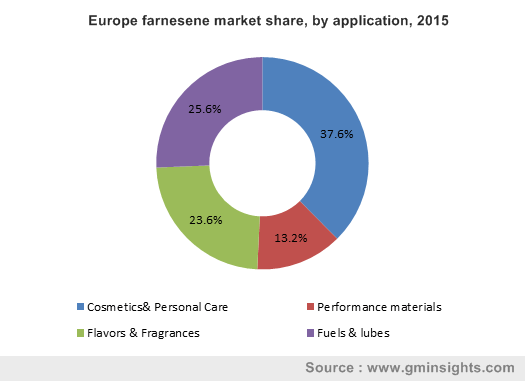Farnesene Market – Global Industry Analysis Report, Share, Size, Growth, Price Trends and Forecast, 2016 – 2023
Publisher : Fractovia | Published Date : 2016-07-12Request Sample
Overview
Farnesene Market size was projected at more than 8 kilo tons for 2015 with a predicted CAGR of greater than 27% by 2023. Production of biofuel was predicted at more than 69 kilo tons of oil equal for 2014. Heavy focus on growing use of biofuel in automobile and aviation segment to prevent carbon emissions will promote farnesene market trend.
Europe farnesene market share, by application, 2015

Key important rules like FQD (Fuel Quality Directive), CAAFI (Commercial Aviation Alternative Fuels Initiative) and RFS2 (Renewable Fuel Standard) setup by European Union to drive the demand & use of biofuel in aviation segment.
Biomass derived jet & diesel fuels may be utilized as cost effective and drop-in substitution for traditional fuels. U.S EPA (United States Environmental Protection Agency) has approved the farnesene extracted renewable diesel for blending up to 35.1% with no sulphur constituents.
American Society for testing and materials (ASTM) has also changed its standards for renewable farnesene utilization blended with jet fuels in aviation. ASTM certified fuels have no technical issues related with flights nor do they have security concerns. All these factors have promoted the demand and growth of the global farnesene industry.
However, key feedstock and sugarcane industry can be adversely affected by unsuited climatic conditions and this can hinder the growth of the global farnesene market. Further, sugarcane manufactured in Brazil contributes for more than half of ethanol production. All these are the key aspects accountable for fluctuations in the farnesene market price trends. Also, alternate bio jet fuels like hydrogen peroxide (HPO) and high efficiency particulate arrestance (HEPA)used in aviation sector bio jet fuels may hinder the industry growth.
Application Overview
Farnesene industry is segmented into various applications like cosmetics & personal care applications and performance material applications.
Cosmetics & personal care application segment led the industry with demand evaluated at more than $12 million for 2015. The farnesene industry size may grow due to rise in Squalene demand.
Performance material application segment is predicted to register CAGR of over 40% by end of forecast period. High purity derived item can be utilized in production and is currently tested by firms in their performance formulations and security procedures. For instance, polymerized farnesene can easily react with tire rubber and attain strong adhesion of rubber parts for enhancing shape and performance stability.
Regional Overview
Europe farnesene market generated more than $15 million revenue for 2015.Heavy focus on utilizing sustainable products derived from biomass along with ecological measures taken to eradicate green house gas emissions is predicted to stimulate the demand for farnesene in the region. Europe is dominated by France, Germany and UK farnesene market.
APAC is predicted to expand substantially and register 28% CAGR during forecast timeframe. Rise in per capita disposable expenditure ability along with presence of many big production firms may promote the demand in the region during forecast period.
Latin America, led by Brazil, predicts heavy gains during forecast timeframe. Favourable weather conditions to produce sugarcane crops all over the year in North east as well as Centre –South of Brazil can positively affect the product demand in Latin America.
Competitive Trends
Key industry players profiled in the report include IFF,Kuraray, Intrexon Corporation, Total, Amyris Incorporation and Chromatin Incorporation.
Global farnesene industry is led by Amyris Incorporation which utilises yeast to produce through biotechnology method.Firms like IFF, Total and Kuraray have partnered with Amyris to produce target molecule for using it in relative applications like fragrances, fuel, flavours and tire.
Intrexon has acquired laboratory scale production method through methane bioconversion while chromatin has created sorghum plant with enhanced product level by using gene stacking procedure.
Download a sample copy of this report: https://www.gminsights.com/request-sample/detail/419